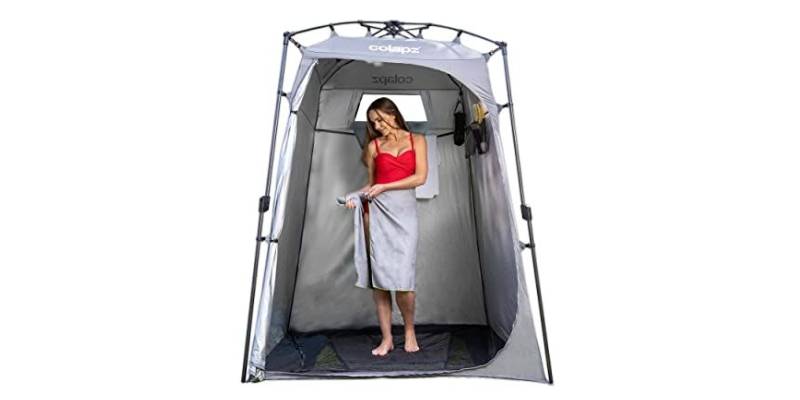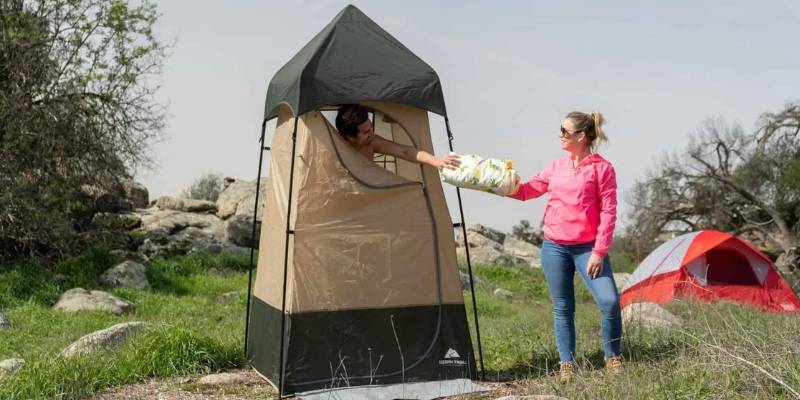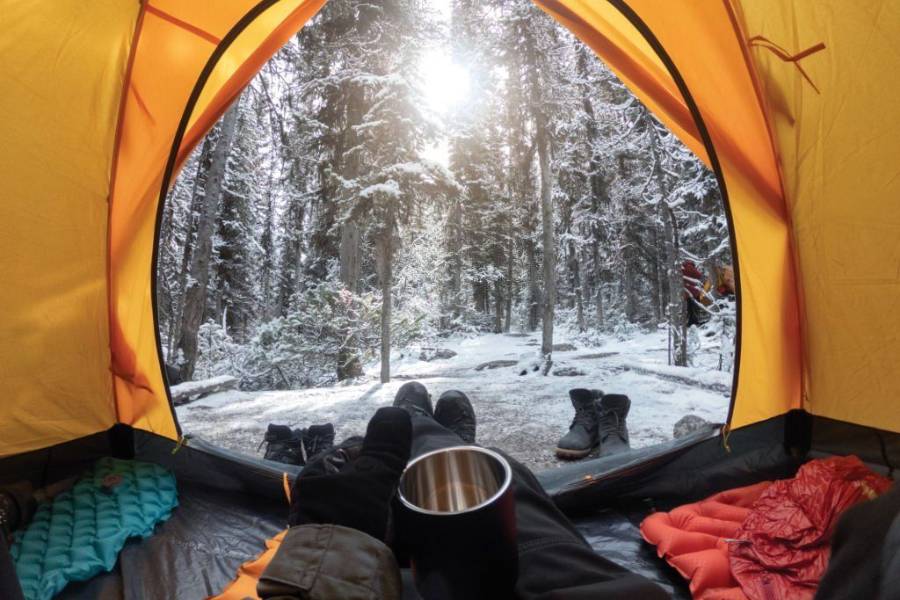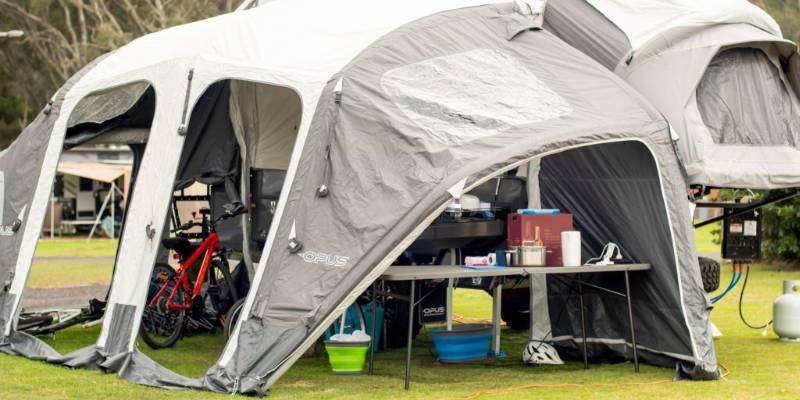Best Rooftop Tents of 2025 (Tested)
Rooftop tents combine the feeling of freedom of normal tents with the comfort of a stable bed. These ingenious shelters combine convenience, comfort, and mobility, which allow adventurers to take their camping trips to new heights—quite literally!
We tested 20 models and finally selected the top 6 best rooftop tents for 2025. Whether you’re a solo traveler, a couple seeking a romantic getaway, or a family in search of a memorable bonding experience, these tents are designed to meet your specific needs.
In the buying guide section, we present the most important facts for making an informed purchase decision. This saves you time and money, ensuring that you find your personal test winner.
Best Rooftop Tents of 2025 (Top 6 Picks)
Let’s discover which one can be your ideal companion for the year ahead!
- 1. Ikamper Skycamp 3.0 Mini Rooftop Tent – Best Overall
- 2. Body Armor 20010 SKY RIDGE PIKE – Entry-level Rooftop Tent
- 3. Thule Tepui Explorer Ayer 2 – Best Budget Rooftop Tent
- 4. Roofnest Condor XL – Fold-out Style Rooftop Tent
- 5. Smittybilt Overlander Tent – Best for Overlanding
- 6. Xljh Camping Rooftop Tent – Spacious for 2 Person
1. Ikamper Skycamp 3.0 Mini Rooftop Tent
Specs:
- Type: Hard Shell Rooftop Tent
- Lying surface: 83 x 52 in
- Height (Closed/Open): 13.5” / 48”
- Weight: 125 Pounds
- Number of people: 2
- Seasons: 4-Season
The Skycamp 3.0 Mini hard shell rooftop tent impresses us with its compact design and easy handling. The locks, hinges, and ladder hangers are extremely stable. It is an all-rounder rooftop tent that offers a convincing shelter with excellent comforts for holidays of all kinds.
The assembly is done within a few minutes. It is foldable so the tent can be moved easily. Thanks to the hard shell, it reliably protects against rain. The mosquito nets effectively keep mosquitoes away. The high-quality zippers and improved windows allow you to open canvas and mesh simultaneously.
Various inner compartments help keep things tidy inside the tent. The ladder can be flexibly attached to both long sides of the vehicle, enabling access from either side. Furthermore, the canopies provide reliable protection against strong sunlight and rain.
A special feature is the additional roof rack on the hard shell, which makes it possible to take additional luggage of up to 50 kg. With a width of 53 inches, the tent provides a cozy space for two people, making it rather unsuitable for three individuals. Also, tall individuals may find it challenging due to the tent’s length of 83 inches.
Pros
- Robust all-aluminum construction
- Very stable and cozy
- Easy handling and setup
- Inside pockets and shoe pockets
- Two sides entrance
- Additional roof rack for luggage
- Fits all vehicles
Cons
- Lying surface is comparatively narrow
- Mattress is a bit firm
2. Body Armor 20010 SKY RIDGE PIKE Rooftop Tent
Specs:
- Type: High-Density Rooftop Tent
- Lying surface: 50 x 47 in
- Height (Closed/Open): 13” / 48”
- Weight: 117 Pounds
- Number of people: 2
- Seasons: 4-Season
The Body Armor SKY RIDGE PIKE high-density rooftop tent is characterized by a stable and robust hardcover construction, which allows quick and easy assembly with just a few movements. With this rooftop tent, every camping holiday will be great fun.
The assembly set and the illustrated assembly instructions help to fix the tent correctly to the cross members of the car before use (You don’t have another person to help). Two adults have plenty of sleeping space in the inner tent. The double-wall construction ensures top-class ventilation while protecting against mosquitoes.
Thanks to four large windows, an all-around view is possible and promises an absolute feeling of freedom in nature! With a hydrostatic head of 3000 mm, you stay dry every night in the tent. The darkened windows also allow restful sleep even after sunrise. The rainfly prevents water from coming in at all.
The material quality feels durable for the price. We highly recommend this option for novice campers looking to utilize their vehicle as a sleeping space while keeping their camping gear outside.
Pros
- Stable aluminum lid
- Easy opening with gas pressure springs
- Robust outer tent
- Completely waterproof
- Inner tent can be almost completely blacked out
- Covered entrance area
- Quick and easy assembly
- Good ventilation
Cons
- Thin mattress
- Small floor space
3. Thule Tepui Explorer Ayer 2 Rooftop Tent
Specs:
- Type: Hard Shell Rooftop Tent
- Lying surface: 84 x 44 in
- Height (Closed/Open): 10” / 44”
- Weight: 114 Pounds
- Number of people: 2
- Seasons: 4-Season
The Thule Tepui Explorer Ayer 2 rooftop tent impresses us with its extremely robust and high-quality hard shell cover, which offers optimal protection when driving, camping, and storing. Anyone who spares no expense and travels as a couple can opt for this high-quality and robust tent.
The shell opens fully automatically, which saves a lot of time during assembly. This guarantees more time for nicer activities on the campsite. The hardcover roof is waterproof and therefore trumps all rooftop tent fabric models. The tent is also well protected against rain from the sides thanks to the robust polyester fabric.
Furthermore, the material is UV-resistant and therefore a faithful companion even in strong sunlight. The mesh panels offer plenty of ventilation and airflow. Whether it’s exploring the spectacular nature of the great outdoors or traveling the world with family and friends, the Thule Tepui Explorer Ayer 2 rooftop tent will be the best companion. It can accommodate up to two people and necessary gear.
However, the lying surface is slightly narrower, and the tent is somewhat flatter compared to the previous two models. Also, it’s important to avoid using this tent with any type of clamp-style roof rack.
Pros
- Set up particularly quickly
- Four large internal pockets
- Very waterproof thanks to the hardcover
- Comes with 2 years warranty
- Built with UV protection
- Mosquito nets
Cons
- Narrow lying surface
- Relatively flat
4. Roofnest Condor XL Fold-out Style
Specs:
- Type: Fold-out Hard Shell Rooftop Tent
- Lying surface: 74 x 93 in
- Height (Closed/Open): 13” / 50”
- Weight: 160 Pounds
- Number of people: 3-4
- Seasons: 4-Season
The Roofnest Condor XL 4-season tent is UV-resistant and waterproof. Thanks to the thick fabric construction and effective insulation, it can be used all year round without the cold outside getting in. It fits two to three people cozily, making it suitable for couples or small families.
The medium doors and windows make a great impression and promise a great indoor climate inside the tent. Thanks to the outer shell, it protects against wind and weather. The shell is made of ABS plastic with Line-X Finish, making it extremely robust.
The aircraft aluminum frame ensures that the tent is well protected and cannot be damaged during long car journeys or when stored. A small awning is integrated, which protects against rainwater when exiting. Internal storage compartments also help to keep the tent tidy and not lose sight of your belongings.
The minimum distance front-back between rack crossbars is 30 inches. The package comes with an 8.5′ ladder, 2 detachable pockets, Roofnest privacy tent, 4×4 ground mat, and interior LED light. It makes tours throughout the year possible and offers the highest level of comfort and safety.
Pros
- Simple lifting system
- Ergonomic design
- Lots of doors and windows
- Tear-resistant tent fabric
- Waterproof and durable
- Internal storage compartments
- All-season tent
- Awning and specious
Cons
- No information on the water column
- Not designed for solo travelers
5. Smittybilt Overlander Rooftop Tent
Specs:
- Type: Vehicle Mounted Tent
- Lying surface: 92 x 55 in
- Height (Closed/Open): 13” / 51”
- Weight: 116.5 Pounds
- Number of people: 2
- Seasons: 4-Season
Smittybilt Overlander rooftop tent comes in a slim and compact design, which offers plenty of space when set up. Once the pitch has been found, it can be easily unfolded and set up quickly with the help of long pegs and cross poles.
Entry from all sides makes a great impression and makes the tent easier to use. This is especially useful during the night when someone wants to leave the tent without disturbing others. The LED light works great with a USB battery pack. It has two skylights; you can enjoy the night sky from your tent.
The openings are equipped with mosquito nets, so the interior is safe from mosquitoes. Smittybilt also states that the tent is UV-resistant and waterproof. The rainfly is waterproof and treats well in light rain or drizzle by itself. This model comes with heavy duty PVC cover to keep the tent safe.
Overall, if you are looking for a practical rooftop tent with lots of space and many great features and don’t want to dig too deep into your pocket, you will find it in the Smittybilt Overlander. The thickness of the fabric is remarkable.
The disadvantage is the high weight of the tent as a 2-person tent; 116.5 pounds does not perform as well as the other models in our test. Nevertheless, the price of the tent is unbeatable.
Pros
- Compact when packed
- Plenty of space for two people
- Entry is possible from all sides
- Awnings and Breathable
- Lightweight aluminum telescopic ladder
- Waterproof
Cons
- A bit hard to remove rainfly
- Very loud when it’s windy
6. Xljh Camping Spacious Rooftop Tent
Specs:
- Type: Hard Shell Folding Tent
- Lying surface: 83 x 56 in
- Height (Closed/Open): 13” / 55”
- Weight: 152.5 Pounds
- Number of people: 2
- Seasons: 4-Season
If you need a large and comfortable addition with lots of space, you will find it in the Xljh rooftop tent. It is a hybrid tent, combined with a hard shell tent and a fabric tent, offering the advantages of both models. In its unfolded form, it achieves a significantly larger area and thus offers increased comfort.
A huge plus is the high walls compared to other tents (1.40 m high). Also, very pleasant features include the covered entrance area and the cozy awning, which promise enjoyable and comfortable hours even in rainy weather. It comes with its own awning, not a separate awning.
This tent is specifically designed for 4×4 off-road vehicles, making it suitable for adventurous camping trips in rugged terrains. It is constructed with a durable fiberglass roof to withstand the challenges of off-road travel. Ventilation is also optimal. Thanks to the opening windows, they offer protection even in the rain.
There are two small drawbacks to consider. Firstly, the weight is relatively high compared to other tents mentioned above. Additionally, some users may find the water column rating of 2000 mm to be lower than expected for the price, potentially affecting its ability to provide optimal protection against heavy rain.
Pros
- Rain-protected entrance area
- Integrated sponge mattress
- Lots of space inside
- Awning and good ventilation
- Comparatively high
Cons
- High weight
- Low rain protection
What You Need to Consider When Buying a Rooftop Tent
With the diverse range of options available on the market, choosing the right rooftop tent can be a challenging task. Here are some essential factors & properties to consider before making your purchase:
Type of rooftop tent
There are various types of rooftop tents available on the market, each with its own features and benefits. Some common and popular types include:
- Hardshell Rooftop Tents: These tents have a durable, aerodynamic hardshell construction that offers protection from the weather and can be easily set up and collapsed. They often feature built-in mattresses and are known for their quick setup times.
- Softshell Rooftop Tents: Softshell rooftop tents are made of durable and weather-resistant fabric that can withstand harsh weather. They are usually light compared to hardshell tents and offer flexibility in terms of setup and packing.
- Pop-Up Rooftop Tents: Pop-up rooftop tents are designed to be quickly and easily erected, often with a simple push-up mechanism. They are compact when folded down but provide ample sleeping space when fully deployed.
- Hybrid Rooftop Tents: Hybrid rooftop tents combine features of both hardshell and softshell tents, offering a balance of durability, convenience, and comfort. They feature a hardshell base with a soft fabric top or vice versa.
- Vehicle-Specific Rooftop Tents: Some rooftop tents are designed to be compatible with specific vehicle models or roof rack systems to ensure a secure and snug fit.
Size & available space
When considering the size and available space of a rooftop tent, several factors come into play:
- Sleeping Capacity: Rooftop tents come in various sizes to accommodate different numbers of sleepers. They range from single-person tents to larger ones capable of sleeping four or more people. Consider how many people will be using the tent to ensure everyone has enough space to sleep comfortably.
- Dimensions: Pay attention to the dimensions both set up and packed away. This includes both the footprint on the roof of your vehicle and the interior space when the tent is opened up. Ensure that the tent will fit securely on your vehicle’s roof rack and that there’s enough headroom and sleeping area inside.
- Interior Features: Consider the layout and features inside the tent, such as storage pockets, gear lofts, and additional living space. These can affect the available space and organization options for your gear and personal belongings.
Cost
Good rooftop tents generally range in price from $800 to $3000 or more, depending on factors such as brand reputation, size, features, and materials. Entry-level models with basic features may start around $800 to $1200, while premium models with advanced features and durable construction can cost $2000 to $3000 or higher. Consider your budget, camping needs, and desired features when choosing a rooftop tent.
Material
Rooftop tents are constructed using a variety of materials to ensure durability, weather resistance, and comfort. Some common materials used in rooftop tent construction include:
- Fabric: The tent fabric is usually a heavy-duty material such as canvas or polyester. Canvas is known for its durability and breathability, making it a popular choice for rooftop tents. Polyester fabrics are often lighter and may offer better water resistance.
- Frame: The frame of the rooftop tent is made of lightweight yet sturdy materials such as aluminum or steel. Aluminum frames are preferred for their rust resistance and lightweight properties, while steel frames are known for their strength and durability.
- Mattress: Most rooftop tents come with a built-in mattress for sleeping comfort. These mattresses are usually made of high-density foam or memory foam to provide adequate support and cushioning.
- Zippers and Hardware: Quality zippers and hardware are essential for the longevity and functionality of a rooftop tent. Look for tents with heavy-duty zippers and corrosion-resistant hardware made of materials like stainless steel or nickel-plated brass.
- Insulation: Some rooftop tents feature additional insulation layers to help regulate temperature and improve comfort in various weather conditions. Insulation materials may include foam or reflective layers to trap heat or reflect sunlight.
- Mesh Panels: Mesh panels are often integrated into rooftop tents to provide ventilation while keeping bugs and insects out. These panels are generally made of durable yet breathable materials, like nylon or polyester mesh.
Seasonality and Climate
Consider the type of weather and climate you’ll be camping in. Some tents are designed for all-season use, while others are better suited for specific conditions. Look for tents with proper ventilation and insulation features.
Ventilation and Condensation Management
Adequate ventilation is crucial for minimizing condensation inside the tent. Look for tents with mesh windows and vents that promote airflow. This is especially important for long-distance travelers.
Additional Features
Consider features that enhance comfort and convenience during outings. Look for amenities like built-in LED lighting, which provides illumination during nighttime activities, and annex rooms that offer additional living space for relaxing or storage. These features can greatly enhance the overall camping experience and make your adventures more enjoyable.
Build a Rooftop Tent Yourself – Is That Possible?
Building a rooftop tent yourself is indeed possible, drawing on the experiences of DIY enthusiasts in the rooftop tent community. Here are the key steps to successfully construct your own rooftop tent:
- Determine the Basic Framework: Decide on the foundation of your tent, whether it’s a shell made from glued and screwed screen printing board or a wooden frame onto which the mattress will be placed.
- Select Sturdy Materials for the Mechanism: Opt for robust steel for the hinge scissors, which will push an aluminum or steel frame upwards with the assistance of compression springs. Alternatively, you can explore erectable folding mechanisms without springs for simplicity.
- Choose Waterproof Fabric for Roof Covering: Select a durable and waterproof fabric for the roof covering. Many DIYers find that truck tarpaulin works exceptionally well for this purpose. Ensure that the side walls are made of breathable fabric, such as polyester or nylon tent material, to promote ventilation.
- Securely Attach the Roof Tarpaulin: Once the framework and fabric are in place, ensure that the roof tarpaulin adequately covers the tent’s frame when folded. Attach the tarpaulin securely to the frame using rivets, and consider additional fastening options, such as snaps or elastic bands, for added security during travel.
FAQs
Which roof racks are best for a rooftop tent?
Some of the best roof racks for rooftop tents include brands like Thule, Yakima, Front Runner, and Rhino-Rack. These racks are known for their sturdy construction, high weight capacities, and compatibility with various vehicle models. Look for roof racks specifically designed for heavy-duty use and capable of supporting the weight of your rooftop tent.
Where can you stay overnight with a rooftop tent?
You can stay overnight with a rooftop tent in various places, including campgrounds, national parks, state parks, remote wilderness areas with dispersed camping, beaches, private property with permission, and specialized rooftop tent campsites. Ensure you follow local regulations, obtain necessary permits, and respect the environment wherever you choose to camp.
- More information about wild camping can be found here.
Which rooftop tent fits my car?
The rooftop tent that fits your car depends on several factors, including the make and model of your vehicle, the type of roof rack system you have installed, and the weight capacity of both your vehicle and the roof rack. Many rooftop tent manufacturers provide compatibility information on their websites or product listings, specifying which vehicles and roof rack systems their tents are designed to fit.
Is it possible to rent a rooftop tent?
Yes, it is possible to rent a rooftop tent from various rental companies, outdoor gear shops, and specialized camping equipment providers. Renting a rooftop tent can be a convenient and cost-effective option, especially if you only need it for occasional use or want to try out different models before making a purchase.
How to store a rooftop tent correctly?
Before storing, make sure that the mattress and tent fabric are dry. Theoretically, rooftop tents are designed in such a way that they can remain on the vehicle all year round. However, we recommend dismantling it during longer camping breaks and storing it in a dry place that is as dust-free as possible. For better ventilation, open the rooftop tent from time to time and place it in the sun.
How fast can you drive with a rooftop tent?
Most rooftop tents are approved up to a maximum of 130 km/h, the required roof racks are often only up to 120 km/h. Higher speeds not only result in unsafe driving behavior of the car but also in annoying driving noises.
How far can a rooftop tent protrude?
In principle, a vehicle, including its load, must not be wider than 2.55 m and not higher than 4 m. If the rooftop tent protrudes more than 40 cm to the side or 1.50 m to the rear, it must be marked with a flag or something similar.
How is a rooftop tent properly attached?
In most models, the rooftop tent is attached to the floor using aluminum or steel profile rails with cross beams on the vehicle roof. For assembly, it is good to have at least two people, better three, to be able to handle the tent better and fix it evenly from the sides.
How much does a rooftop tent weigh?
The weight of rooftop tents can vary significantly depending on factors such as size, materials, and features. On average, rooftop tents weigh between 100 to 220 pounds (45 to 100 kilograms). However, there are lighter options available for smaller tents and heavier options for larger, more robust tents with additional features.
Can a rooftop tent withstand strong winds or even a storm?
Rooftop tents are usually extremely weather-resistant and can withstand even stronger storms. However, it quickly becomes uncomfortable in terms of volume and vibrations. This can be prevented with good relaxation and foresighted choice of parking space.
Conclusion
Buying a rooftop tent means you are making a tidy investment in the future, so it is crucial to find the right model that suits your specific needs. As we wrap up our exploration of the best rooftop tents of 2025, it’s clear that these innovative shelters have redefined the art of camping. From their ease of installation to the comfort they provide, they are ideal companions for adventurers seeking a seamless blend of mobility and comfort.












